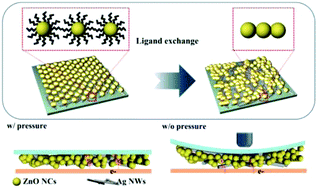One-step chemical treatment to design an ideal nanospacer structure for a highly sensitive and transparent pressure sensor†
Abstract
Highly transparent and sensitive pressure sensors with a wide detection range were developed by a simple process using silver nanowires and ZnO nanocrystals (NCs) without lithography. The open mesh structured spacers were sucessfully designed by one-step chemical treatment involving a ligand exchange process on the ZnO NC thin films, leading to improved sensitivity, responsivity and transparency. The device performance analyses along with chemical, structural, and electronic characterization studies reveal that the chemically designed pressure sensor has a record-breaking sensitivity of 3.23 × 103 kPa−1, a large detection range of up to 75 kPa, excellent reliability, and high transparency of 85% in the visible-light region. The origin of improved sensitivity was explained with the contact area variation theory. We also demonstrate that the pressure sensor fabricated by the all-solution-based facile process can be employed in various applications such as wearable sensors for measurement of the human pulse and attachable electronics for an electronic skin with a wide sensing range of pressures.



 Please wait while we load your content...
Please wait while we load your content...